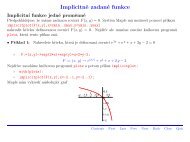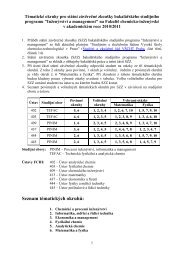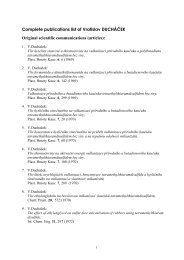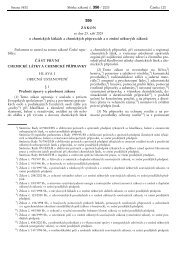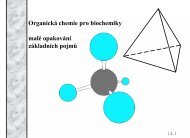Vlastní čísla a vlastní vektory
Vlastní čísla a vlastní vektory
Vlastní čísla a vlastní vektory
You also want an ePaper? Increase the reach of your titles
YUMPU automatically turns print PDFs into web optimized ePapers that Google loves.
400200–10 –8 –6 –4 –2 2lambda4 6 8 100–200–400400200–10 –8 –6 –4 –2 2 4 6 8 10pi–200–400Figure 1: Polynom charpFigure 2: Polynom charp2Na obrázcích 1 a 2 jsou znázorněny polynomy charp a charp2.> chareq:=det(B) = 0;> solve(chareq, {λ});chareq := −119 + 46 λ + λ 2 − λ 3 = 0Contents First Last Prev Next Back Close Quit
evalf(%);{λ = −11188 + 12 I √ }324363 (1/3)278+63 −11188 + 12 I √ + 1 ,324363 (1/3) 3{λ = − −11188 + 12 I √ 324363 (1/3)139−123 −11188 + 12 I √ + 1 324363 (1/3) 3 ++ 1 2 I √ (−11188 + 12 I √ )}324363 (1/3)3− 278 ,63 %1 (1/3){λ = − −11188 + 12 I √ 324363 (1/3)139−123 −11188 + 12 I √ + 1 324363 (1/3) 3 −− 1 2 I √ (−11188 + 12 I √ )}324363 (1/3)2783−63 −11188 + 12 I √ 324363 (1/3){λ = 5.435111408 − 0.1 10 −8 I}, {λ = −7.395608304 + 0.1339745960 10 −9 I},{λ = 2.960496896 + 0.1866025404 10 −8 I}> λ1 := 5.435111408 − .1e − 8 ∗ I;λ1 := 5.435111408 − 0.1 10 −8 I> λ2 := −7.395608304 + .1339745960e − 9 ∗ I;λ2 := −7.395608304 + 0.1339745960 10 −9 I> λ3 := 2.960496896 + .1866025404e − 8 ∗ I;λ3 := 2.960496896 + 0.1866025404 10 −8 IContents First Last Prev Next Back Close Quit
evalf(eigenvalues(A));5.435111408 − 0.1 10 −8 I, −7.395608304 + 0.1339745960 10 −9 I,2.960496896 + 0.1866025404 10 −8 IOba postupy nám tedy nalezly stejná <strong>vlastní</strong> <strong>čísla</strong>. Tato <strong>vlastní</strong> <strong>čísla</strong> jsou ”téměř” reálná. Z obrázkucharakteristického polynomu (Obrázek 1, Obrázek 2) vidíme, že kdybychom počítali přesně, měli bychomzískat tři reálné kořeny, a tedy tři reálná (různá) <strong>vlastní</strong> <strong>čísla</strong>. Nepřesnost výsledku způsobuje jednakpoužití numerické metody při výpočtu, jednak zaokrouhlovací chyby.Zkusme ještě symbolický výpočet například pro diagonální matici:> DM:=array([[a,0,0],[0,b,0],[0,0,c]]);⎡DM := ⎣a 0 00 b 00 0 c> eigenvalues(DM);a, b, cVidíme, že v případě diagonální matice jsou všechna <strong>vlastní</strong> <strong>čísla</strong> diagonální prvky dané matice.> eigenvectors(DM);[a, 1, {[1, 0, 0]}], [b, 1, {[0, 1, 0]}], [c, 1, {[0, 0, 1]}]Výsledek, říká, že a je jednoduché <strong>vlastní</strong> číslo, kterému přísluší <strong>vlastní</strong> vektor [1, 0, 0]. Obdobně pro<strong>vlastní</strong> <strong>čísla</strong> b a c.> DM1:=array([[1,0,0],[0,1,0],[0,0,1]]);⎤⎦Contents First Last Prev Next Back Close Quit
eigenvectors(DM1);⎡DM1 := ⎣1 0 00 1 00 0 1[1, 3, {[1, 0, 0], [0, 0, 1], [0, 1, 0]}]Tedy matice DM1 má jedno <strong>vlastní</strong> číslo rovno 1 s algebraickou násobností 3 a odpovídající <strong>vlastní</strong><strong>vektory</strong> jsou <strong>vektory</strong> (1, 0, 0) T , (0, 1, 0) T , (0, 0, 1) T .Jaké jsou <strong>vlastní</strong> <strong>vektory</strong> matice A?> evalf(eigenvectors(A));[5.435111408 − 0.1 10 −8 I, 1.,{[−0.179489876 + 0.5105777948 10 −8 I, 0.127810768 + 0.1252888975 10 −8 I, 1.]}], [−7.395608304 + 0.1339745960 10 −9 I, 1.,{[1.79828530 + 0.1847745082 10 −9 I, −5.298661502 + 0.3593745522 10 −9 I, 1.]}],[2.960496896 + 0.1866025404 10 −8 I, 1.,{[7.524061680 − 0.4775368097 10 −8 I, 2.742279288 − 0.1254671347 10 −8 I, 1.]}]<strong>Vlastní</strong> <strong>vektory</strong> matice A mají opět ”zanedbatelnou” imaginární část:> v1:=vector([1., -.712077918+.5394248717e-9*I,> -5.571345162+.2918274615e-8*I]);v1 := [1., −0.712077918 + 0.5394248717 10 −9 I, −5.571345162 + 0.2918274615 10 −8 I]> v2:=vector([1., -2.946507676+.1156248156e-9*I,> .556085283+.628998508e-10*I]);⎤⎦Contents First Last Prev Next Back Close Quit
v2 := [1., −2.946507676 + 0.1156248156 10 −9 I, 0.556085283 + 0.628998508 10 −10 I]> v3:=vector([1., .3644679428-.5489823192e-9*I,> .132906932-.3662972362e-8*I]);v3 := [1., 0.3644679428 − 0.5489823192 10 −9 I, 0.132906932 − 0.3662972362 10 −8 I]Znázorněme si ještě některé naše výsledky graficky:> matrixplot(A,axes=boxed);42A 0–2–4–611.5column22.5332.52row1.51> matrixplot(A,heights=histogram,axes=boxed);Contents First Last Prev Next Back Close Quit
42A 0–2–4–61 1.52 2.5column 3 3.54433.522.5row11.5> a1 :=> arrow(, shape=arrow, width=[0.02,> relative], head_length=[0.1, relative], color=black):a2 :=> arrow(,shape=arrow, width=[0.02,> relative], head_length=[0.2, relative], color=blue): a3 :=> arrow(,shape=arrow, width=[0.1,> relative], head_length=[0.3, relative],> color=cervena):display(a1,a2,a3, scaling=constrained,> axes=FRAMED);Contents First Last Prev Next Back Close Quit
0–1–2–3–4–5–3–2–1010Je-li v1 <strong>vlastní</strong> vektor příslušný <strong>vlastní</strong>mu číslu λ1 matice A, pak vektor Av1 je jeho λ1−násobkem:> w1:=evalm(A&*v1);w1 := [5.435111408 − 0.1300000000 10 −8 I, −3.870222812 + 0.2600000000 10 −8 I,−30.28088165 + 0.1567022282 10 −7 I]> p1 := arrow(,, difference,> color=black):p2 :=> arrow(,,shape=arrow,> width=[0.02, relative], head_length=[0.2, relative], color=blue):> display(p1,p2,axes=FRAMED);Contents First Last Prev Next Back Close Quit
0–5–10–15–20–25–30–3–2–10543210Příklady k procvičení1. Najděte <strong>vlastní</strong> <strong>čísla</strong> a <strong>vlastní</strong> <strong>vektory</strong> matice (graficky znázorněte)⎛1 −6⎞3A = ⎝ 1 1 0 ⎠ .2 0 12. Najděte <strong>vlastní</strong> <strong>čísla</strong> a <strong>vlastní</strong> <strong>vektory</strong> matice (graficky znázorněte)⎛1 1⎞2A = ⎝ −6 1 0 ⎠ .3 0 1Contents First Last Prev Next Back Close Quit
3. Najděte <strong>vlastní</strong> <strong>čísla</strong> a <strong>vlastní</strong> <strong>vektory</strong> matice A a matice A 2 (graficky znázorněte)( ) 1 1A = .6 04. Najděte <strong>vlastní</strong> <strong>čísla</strong> a <strong>vlastní</strong> <strong>vektory</strong> matice⎛A =⎜⎝2 −3 1 −13 1 −2 0−5 2 0 10 2 −1 1⎞⎟⎠ .5. Najděte <strong>vlastní</strong> <strong>čísla</strong> a <strong>vlastní</strong> <strong>vektory</strong> matice⎛A =⎜⎝2 1 0 01 0 −1 20 0 1 −10 1 0 −1⎞⎟⎠ .6. Najděte <strong>vlastní</strong> <strong>čísla</strong> a <strong>vlastní</strong> <strong>vektory</strong> matice⎛A =⎜⎝2 0 1 00 −1 1 01 2 0 −10 −1 0 1⎞⎟⎠ .Contents First Last Prev Next Back Close Quit
7. Najděte <strong>vlastní</strong> <strong>čísla</strong> a <strong>vlastní</strong> <strong>vektory</strong> matice (graficky znázorněte)⎛2 −1⎞0A = ⎝ 5 3 −2 ⎠ .4 −1 1Contents First Last Prev Next Back Close Quit



